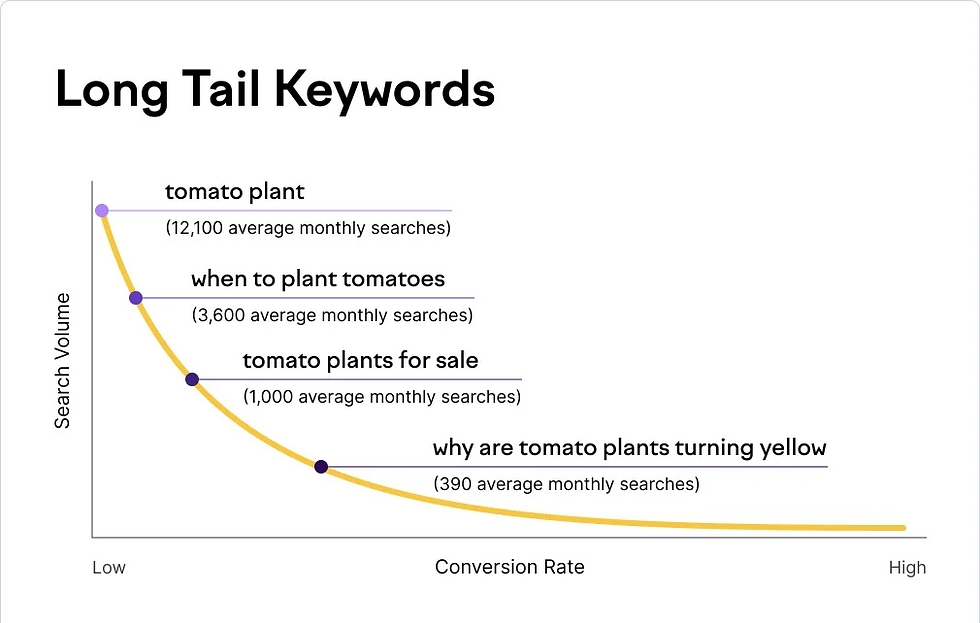Long-Tail Keywords: The High-Intent Traffic Strategy Most Brands Ignore
- Tsamarah Balqis
- 1 day ago
- 4 min read
Let’s face it, ranking for “digital marketing,” “skincare,” or “best travel agency” is like trying to shout in a stadium full of people.
Everyone’s doing it.

But smart brands? They’ve found a quieter, more strategic path: Long-tail keywords.
These ultra-specific search terms may not get flashy traffic numbers but they consistently bring in highly targeted visitors who are ready to buy, book, or sign up.
Let’s explore what long-tail keywords are, why they matter, and how we at Paper Cut Collective use them to help brands grow smarter (not louder).
What Are Long-Tail Keywords?
Long-tail keywords are search phrases that are:
Longer (usually 3–6+ words)
More specific
Lower in search volume
Higher in buyer intent
For example:
Short-tail: “moisturiser”
Long-tail: “best moisturiser for dry skin in Singapore”
The difference? The long-tail version is exactly what someone types when they’re ready to buy.
Why Long-Tail Keywords Matter (Especially in 2025 SEO)
While short-tail keywords still matter for visibility and branding, long-tail keywords are where real conversions live.
Here’s why:
Higher intent: You reach people who know what they want.
Voice search-friendly: “Hey Siri, what’s the best sunscreen for acne-prone skin?”
Lower competition: Easier to rank, especially for new or growing brands.
Higher ROI: You’re not just getting clicks you’re getting leads and sales.
At Paper Cut Collective, we often say:
“Don’t just chase volume capture intent.”
Long-Tail vs. Short-Tail Keywords: A Quick Comparison
Short-tail keywords are broad search terms, like “digital marketing,” that tend to have very high search volume and intense competition. While they’re useful for building brand awareness and reaching a wide audience, they typically have lower conversion rates because the user intent is vague.
On the other hand, long-tail keywords such as “affordable digital marketing for SMEs SG” are more specific, often used by users who are closer to making a purchase or taking action.
These keywords usually have lower search volume but also face less competition, making them easier to rank for and more likely to convert.
Real-Life Long-Tail Keyword Examples
Here’s how we’ve helped clients tap into long-tail intent:
Beauty brand “vegan moisturiser for sensitive skin Singapore”
Travel brand “private Bali honeymoon tour with local guide”
B2B SaaS “best task management tool for remote teams 2025”
These keywords don’t just bring traffic they bring the right audience.
How to Find Long-Tail Keywords That Work
You don’t need to rely on guesswork or gut instinct when it comes to finding long-tail keywords. With the right tools and a bit of strategic thinking, you can uncover the exact phrases your potential customers are already searching for.
Use These Tools and Methods:
Google Autocomplete Start typing your main keyword in Google’s search bar and watch the suggestions that appear. These are real queries based on popular searches. For example, type “social media marketing for” and you might see “for small businesses Singapore” or “for F&B brands”—pure long-tail gold.
AnswerThePublic This tool pulls up real questions and search phrases people are typing in around your topic. It’s perfect for identifying FAQ-style long-tail keywords you can turn into blog posts, support articles, or landing pages.
SEMrush / Ahrefs Use the keyword gap tools to see what long-tail keywords your competitors rank for that you don’t. These often reveal niche opportunities you haven’t considered but are already driving traffic elsewhere.
Customer Support Chats & FAQ Pages These are a goldmine for real-world language. What questions do customers keep asking? How do they phrase their problems? Often, their words reflect exactly how they’d search online ideal for long-tail keyword targeting.
Look for keywords that:
Include location, intent, or problem/solution phrasing (e.g., “best hair salon for curly hair in Bukit Timah” or “how to fix a slow Shopify store”)
Reflect natural, conversational language, especially important for voice search and mobile
Are aligned with your offerings whether that’s a product, service, or blog content theme
Indicate clear user intent (questions, comparisons, or purchase signals)
How Paper Cut Collective Uses Long-Tail Keywords Strategically
We don’t just sprinkle long-tail keywords into blog posts and hope for the best.
At Paper Cut Collective, we build SEO systems:
Topic clusters around long-tail search intent
Content strategies designed to rank for multiple variations
Landing pages that match buyer queries precisely
Analytics tracking to measure performance and pivot in real-time
Whether you’re a local brand or scaling startup, long-tail is how you rank faster, convert more, and outsmart bigger competitors.
Final Thoughts: Small Keywords, Big Results
If SEO feels slow, expensive, or ineffective it’s probably because you’re fighting over the wrong keywords.
Long-tail keywords might not grab headlines, but they grab something far more valuable: Searchers who are ready to take action.
Want a Long-Tail SEO Strategy Built for Conversions?
At Paper Cut Collective, we help Singaporean brands win with smarter content, sharper keywords, and SEO strategies that deliver ROI not just rankings.
👉 Visit papercutsg.com and book your free SEO strategy consultation today.
Let’s turn long-tail searches into long-term growth.














